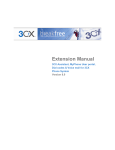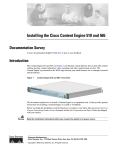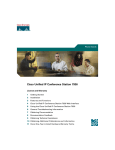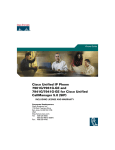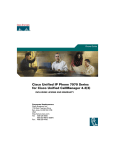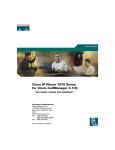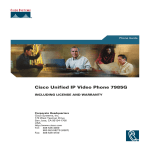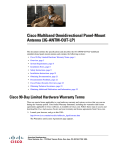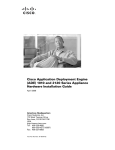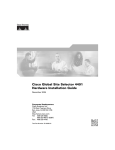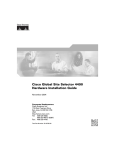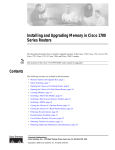Download Cisco Systems 7960G IP Phone User Manual
Transcript
Phone Guide Cisco Unified IP Phone 7960G and 7940G for Cisco Unified CallManager 5.0 (SIP) INCLUDING LICENSE AND WARRANTY Corporate Headquarters Cisco Systems, Inc. 170 West Tasman Drive San Jose, CA 95134-1706 USA http://www.cisco.com Tel: 408 526-4000 800 553-NETS (6387) Fax: 408 526-4100 Press NewCall. The original call is placed on hold automatically. From a connected call, press Confrn. Enter the participant’s phone number and wait for the call to connect. Press Join. From an active call, press more, then Trnsfer. Enter the target number and wait for an answer. Press Trnsfer again. Or press EndCall to cancel the transfer. Press Redial. Press <-- to delete the entry to the left of the cursor. (To move cursor to left, press <<. To move cursor to right, press >>.) Place a call while another call is active Add another participant to a call Transfer a call to a new number Redial a number Edit an entry OL-8134-01 Copyright © 2006 Cisco Systems, Inc. All rights reserved. Cisco, Cisco IOS, Cisco Systems, and the Cisco Systems logo are registered trademarks of Cisco Systems, Inc. or its affiliates in the U.S. and certain other countries. All other brands, names, or trademarks mentioned in this document or Web site are the property of their respective owners. The use of the word partner does not imply a partnership relationship between Cisco and any other company. (0501R) Go off-hook before or after dialing a number. twice Place a call or Press i quickly. View online help on the phone Common Phone Tasks Common Phone Tasks Button Icons Phone Screen Icons Softkey Definitions Cisco Unified IP Phone 7960G and 7940G for Cisco Unified CallManager 5.0 (SIP) Quick Reference Remove a conference participant Resume a call on hold Transfer a call URL dialing mode Resume Trnsfer URL Redial the most recently dialed number Remove Redial Make a new call NewCall Return to the previous screen Exit Display additional softkeys End the current call EndCall more Edit a number in a call log EditDial Join two additional calls already on a single line to create a conference Turn off DND Join Create a conference call DND Setup/cancel call forwarding Confrn CFwdAll Cancel an action and exit the screen without applying changes Transfer a call without talking to the transfer recipient BlndXfr Cancel Answer a call Answer Softkey Definitions On-hook Off-hook Incoming call Phone service URL assigned Message waiting Speed Dial Other Features Speakerphone in use Headset in use Handset in use Selected Device Call State Phone Screen Icons i or Headset Mute Speaker Settings Directories Help Services Messages Button Icons Contents Getting Started 1 Using this Guide 1 Finding Additional Information 2 Safety and Performance Information 2 Accessibility Features 11 Connecting Your Phone 12 An Overview of Your Phone 15 Understanding Buttons and Hardware 15 Understanding Phone Screen Features 18 Cleaning the Phone Screen 18 Understanding Feature Buttons and Menus 19 Entering and Editing Text 19 Understanding the Help System on Your Phone 20 Understanding Lines vs. Calls 20 Understanding Feature Availability 20 Basic Call Handling 21 Placing a Call—Basic Options 21 Placing a Call—Additional Options 22 Answering a Call 22 Ending a Call 23 Using Hold and Resume 23 Using Mute 24 Switching Between Multiple Calls 24 Transferring Calls 25 Forwarding All Calls to Another Number 26 Cisco Unified IP Phone 7960G and 7940G for Cisco Unified CallManager 5.0 (SIP) v Making Conference Calls 27 Do Not Disturb 28 Advanced Call Handling 29 Speed Dialing 29 Using Caller ID Blocking 30 Blocking Anonymous Calls 30 Using Auto-Complete Number 30 Using Call Waiting 31 Using Call Hold Ringback 31 Using Stutter Message Waiting 31 Using Auto Answer (Intercom) 32 Using a Shared Line 32 URL Dialing 32 Using a Handset, Headset, and Speakerphone 33 Obtaining a Headset 33 Using Phone Settings 34 Customizing Rings and Message Indicators 34 Customizing the Phone Screen 34 Using Call Logs and Directories 35 Using Call Logs 35 Using Corporate Directory 36 Using Personal Directory 37 Accessing Voice Messages 38 Customizing Your Phone on the Web 39 Accessing Your User Options Web Pages 39 Configuring Features and Services on the Web 40 Setting Up Phone Services on the Web 40 Controlling Line Settings on the Web 42 vi OL-8134-01 Understanding Additional Configuration Options 43 Troubleshooting Your Phone 44 Viewing Phone Administration Data 44 Cisco One-Year Limited Hardware Warranty Terms 45 Index 47 Cisco Unified IP Phone 7960G and 7940G for Cisco Unified CallManager 5.0 (SIP) vii viii OL-8134-01 Getting Started Using this Guide This guide provides you with an overview of the features available on your phone. You can read it completely for a solid understanding of your phone’s capabilities, or refer to the table below for pointers to commonly used sections. If you want to... Then... Explore your phone on your own Press i or Review safety information See the “Safety and Performance Information” section on page 2. Connect your phone See the “Connecting Your Phone” section on page 12. on the phone when you need assistance. Use your phone after it is installed Start with the “An Overview of Your Phone” section on page 15. Learn what the buttons mean See the “Understanding Buttons and Hardware” section on page 15. Learn about the phone screen See the “Understanding Phone Screen Features” section on page 18. Clean the phone screen See the “Cleaning the Phone Screen” section on page 18. Make calls See the “Placing a Call—Basic Options” section on page 21. Put calls on hold See the “Using Hold and Resume” section on page 23. Mute calls See the “Using Mute” section on page 24. Transfer calls See the “Transferring Calls” section on page 25. Make conference calls See the “Making Conference Calls” section on page 27. Set up speed dialing See the “Speed Dialing” section on page 29. Use your phone as a speakerphone See the “Using a Handset, Headset, and Speakerphone” section on page 33. Change ring volume or tone See the “Using Phone Settings” section on page 34. View your missed calls See the “Using Call Logs” section on page 35. Listen to your voice messages See the “Accessing Voice Messages” section on page 38. Cisco Unified IP Phone 7960G and 7940G for Cisco Unified CallManager 5.0 (SIP) 1 Finding Additional Information You can access the most current Cisco Unified IP Phone documentation on the World Wide Web at this URL: http://www.cisco.com/univercd/cc/td/doc/product/voice/c_ipphon/index.htm You can access the Cisco website at this URL: http://www.cisco.com/ International Cisco websites can be accessed from this URL: http://www.cisco.com/public/countries_languages.shtml Safety and Performance Information Read the following safety notices before installing or using your Cisco Unified IP Phone: Warning IMPORTANT SAFETY INSTRUCTIONS This warning symbol means danger. You are in a situation that could cause bodily injury. Before you work on any equipment, be aware of the hazards involved with electrical circuitry and be familiar with standard practices for preventing accidents. Use the statement number provided at the end of each warning to locate its translation in the translated safety warnings that accompanied this device. Statement 1071 SAVE THESE INSTRUCTIONS Waarschuwing BELANGRIJKE VEILIGHEIDSINSTRUCTIES Dit waarschuwingssymbool betekent gevaar. U verkeert in een situatie die lichamelijk letsel kan veroorzaken. Voordat u aan enige apparatuur gaat werken, dient u zich bewust te zijn van de bij elektrische schakelingen betrokken risico's en dient u op de hoogte te zijn van de standaard praktijken om ongelukken te voorkomen. Gebruik het nummer van de verklaring onderaan de waarschuwing als u een vertaling van de waarschuwing die bij het apparaat wordt geleverd, wilt raadplegen. BEWAAR DEZE INSTRUCTIES 2 OL-8133-01 Getting Started Varoitus TÄRKEITÄ TURVALLISUUSOHJEITA Tämä varoitusmerkki merkitsee vaaraa. Tilanne voi aiheuttaa ruumiillisia vammoja. Ennen kuin käsittelet laitteistoa, huomioi sähköpiirien käsittelemiseen liittyvät riskit ja tutustu onnettomuuksien yleisiin ehkäisytapoihin. Turvallisuusvaroitusten käännökset löytyvät laitteen mukana toimitettujen käännettyjen turvallisuusvaroitusten joukosta varoitusten lopussa näkyvien lausuntonumeroiden avulla. SÄILYTÄ NÄMÄ OHJEET Attention IMPORTANTES INFORMATIONS DE SÉCURITÉ Ce symbole d'avertissement indique un danger. Vous vous trouvez dans une situation pouvant entraîner des blessures ou des dommages corporels. Avant de travailler sur un équipement, soyez conscient des dangers liés aux circuits électriques et familiarisez-vous avec les procédures couramment utilisées pour éviter les accidents. Pour prendre connaissance des traductions des avertissements figurant dans les consignes de sécurité traduites qui accompagnent cet appareil, référez-vous au numéro de l'instruction situé à la fin de chaque avertissement. CONSERVEZ CES INFORMATIONS Warnung WICHTIGE SICHERHEITSHINWEISE Dieses Warnsymbol bedeutet Gefahr. Sie befinden sich in einer Situation, die zu Verletzungen führen kann. Machen Sie sich vor der Arbeit mit Geräten mit den Gefahren elektrischer Schaltungen und den üblichen Verfahren zur Vorbeugung vor Unfällen vertraut. Suchen Sie mit der am Ende jeder Warnung angegebenen Anweisungsnummer nach der jeweiligen Übersetzung in den übersetzten Sicherheitshinweisen, die zusammen mit diesem Gerät ausgeliefert wurden. BEWAHREN SIE DIESE HINWEISE GUT AUF. Cisco Unified IP Phone 7960G and 7940G for Cisco Unified CallManager 5.0 (SIP) 3 Avvertenza IMPORTANTI ISTRUZIONI SULLA SICUREZZA Questo simbolo di avvertenza indica un pericolo. La situazione potrebbe causare infortuni alle persone. Prima di intervenire su qualsiasi apparecchiatura, occorre essere al corrente dei pericoli relativi ai circuiti elettrici e conoscere le procedure standard per la prevenzione di incidenti. Utilizzare il numero di istruzione presente alla fine di ciascuna avvertenza per individuare le traduzioni delle avvertenze riportate in questo documento. CONSERVARE QUESTE ISTRUZIONI Advarsel VIKTIGE SIKKERHETSINSTRUKSJONER Dette advarselssymbolet betyr fare. Du er i en situasjon som kan føre til skade på person. Før du begynner å arbeide med noe av utstyret, må du være oppmerksom på farene forbundet med elektriske kretser, og kjenne til standardprosedyrer for å forhindre ulykker. Bruk nummeret i slutten av hver advarsel for å finne oversettelsen i de oversatte sikkerhetsadvarslene som fulgte med denne enheten. TA VARE PÅ DISSE INSTRUKSJONENE Aviso INSTRUÇÕES IMPORTANTES DE SEGURANÇA Este símbolo de aviso significa perigo. Você está em uma situação que poderá ser causadora de lesões corporais. Antes de iniciar a utilização de qualquer equipamento, tenha conhecimento dos perigos envolvidos no manuseio de circuitos elétricos e familiarize-se com as práticas habituais de prevenção de acidentes. Utilize o número da instrução fornecido ao final de cada aviso para localizar sua tradução nos avisos de segurança traduzidos que acompanham este dispositivo. GUARDE ESTAS INSTRUÇÕES ¡Advertencia! INSTRUCCIONES IMPORTANTES DE SEGURIDAD Este símbolo de aviso indica peligro. Existe riesgo para su integridad física. Antes de manipular cualquier equipo, considere los riesgos de la corriente eléctrica y familiarícese con los procedimientos estándar de prevención de accidentes. Al final de cada advertencia encontrará el número que le ayudará a encontrar el texto traducido en el apartado de traducciones que acompaña a este dispositivo. GUARDE ESTAS INSTRUCCIONES 4 OL-8133-01 Getting Started Varning! VIKTIGA SÄKERHETSANVISNINGAR Denna varningssignal signalerar fara. Du befinner dig i en situation som kan leda till personskada. Innan du utför arbete på någon utrustning måste du vara medveten om farorna med elkretsar och känna till vanliga förfaranden för att förebygga olyckor. Använd det nummer som finns i slutet av varje varning för att hitta dess översättning i de översatta säkerhetsvarningar som medföljer denna anordning. SPARA DESSA ANVISNINGAR Cisco Unified IP Phone 7960G and 7940G for Cisco Unified CallManager 5.0 (SIP) 5 Aviso INSTRUÇÕES IMPORTANTES DE SEGURANÇA Este símbolo de aviso significa perigo. Você se encontra em uma situação em que há risco de lesões corporais. Antes de trabalhar com qualquer equipamento, esteja ciente dos riscos que envolvem os circuitos elétricos e familiarize-se com as práticas padrão de prevenção de acidentes. Use o número da declaração fornecido ao final de cada aviso para localizar sua tradução nos avisos de segurança traduzidos que acompanham o dispositivo. GUARDE ESTAS INSTRUÇÕES 6 OL-8133-01 Getting Started Advarsel VIGTIGE SIKKERHEDSANVISNINGER Dette advarselssymbol betyder fare. Du befinder dig i en situation med risiko for legemesbeskadigelse. Før du begynder arbejde på udstyr, skal du være opmærksom på de involverede risici, der er ved elektriske kredsløb, og du skal sætte dig ind i standardprocedurer til undgåelse af ulykker. Brug erklæringsnummeret efter hver advarsel for at finde oversættelsen i de oversatte advarsler, der fulgte med denne enhed. GEM DISSE ANVISNINGER Cisco Unified IP Phone 7960G and 7940G for Cisco Unified CallManager 5.0 (SIP) 7 8 OL-8133-01 Getting Started Warning Read the installation instructions before you connect the system to its power source. Warning Ultimate disposal of this product should be handled according to all national laws and regulations. Warning Do not work on the system or connect or disconnect cables during periods of lightning activity. Cisco Unified IP Phone 7960G and 7940G for Cisco Unified CallManager 5.0 (SIP) 9 Warning To avoid electric shock, do not connect safety extra low voltage (SELV) circuits to telephone network voltage (TNV) circuits. LAN ports contain SELV circuits, and WAN ports contain TNV circuits. Some LAN and WAN ports use RJ-45 connectors. Use caution when connecting cables. Caution Inline power circuits provide current through the communication cable. Use the Cisco provided cable or a minimum 24 AWG communication cable. Using an External Power Supply The following warnings apply when you use the external power supply with the Cisco Unified IP Phone: Warning This product relies on the building's installation for short-circuit (over current) protection. Ensure that a fuse or circuit breaker no larger than 120 VAC, 15A U.S. (240 VAC, 10A international) is used on the phase conductors (all current-carrying conductors). Warning The device is designed to work with TN power systems. Warning The plug-socket combination must be accessible at all times because it serves as the main disconnecting device. Warning The power supply must be placed indoors. Caution Only use the Cisco-specified power supply with this product. Power Outage Your accessibility to emergency service through the phone is dependent on the phone being powered. If there is an interruption in the power supply, Service and Emergency Calling Service dialing will not function until power is restored. In the case of a power failure or disruption, you may need to reset or reconfigure equipment before using the Service or Emergency Calling Service dialing. 10 OL-8133-01 Getting Started Using External Devices The following information applies when you use external devices with the Cisco Unified IP Phone: Cisco recommends the use of good quality external devices (such as headsets) that are shielded against unwanted radio frequency (RF) and audio frequency (AF) signals. Depending on the quality of these devices and their proximity to other devices such as mobile phones or two-way radios, some audio noise may still occur. In these cases, Cisco recommends that you take one or more of the following actions: • Move the external device away from the source of the RF or AF signals. • Route the external device cables away from the source of the RF or AF signals. • Use shielded cables for the external device, or use cables with a better shield and connector. • Shorten the length of the external device cable. • Apply ferrites or other such devices on the cables for the external device. Cisco cannot guarantee the performance of the system because Cisco has no control over the quality of external devices, cables, and connectors. The system will perform adequately when suitable devices are attached using good quality cables and connectors. Caution In European Union countries, use only external speakers, microphones, and headsets that are fully compliant with the EMC Directive [89/336/EC]. Accessibility Features A list of accessibility features is available upon request. Cisco Unified IP Phone 7960G and 7940G for Cisco Unified CallManager 5.0 (SIP) 11 Connecting Your Phone Your system administrator will likely connect your new Cisco Unified IP Phone to the corporate IP telephony network. If that is not the case, refer to the graphic and table below to connect your phone. 8 1 AUX 10/100 SW 10/100 PC + DC48V 7 2 3 4 5 113656 6 1 DC adaptor port (DC48V) for phones not provided with inline power 5 Access port (10/100 PC) for connecting your phone to your computer 2 AC-to-DC power supply 6 Handset port 3 AC power cord 7 Headset port 4 Network port (10/100 SW) for connecting to the network 8 Footstand button 12 OL-8134-01 Connecting Your Phone Adjusting the Footstand To change the angle that the phone base, adjust the footstand while pressing the footstand button. Adjusting the Handset Rest Cisco recommends adjusting the handset rest, particularly when wall-mounting the phone, as this will ensure that the receiver will not slip out of the cradle. See the table below for instructions. 2 3 120521 1 1 Set the handset aside and pull the square plastic tab from the handset rest. 2 Rotate the tab 180 degrees. 3 Slide the tab back into the handset rest. An extension protrudes from the top of the rotated tab. Return the handset to the handset rest. Headset Information To use a headset, connect it to the headset port on the back of your phone. Although Cisco Systems performs some internal testing of third-party headsets for use with the Cisco Unified IP Phones, Cisco does not certify or support products from headset or handset vendors. Because of the inherent environmental and hardware inconsistencies in the locations where Cisco Unified IP Phones are deployed, there is not a single “best” solution that is optimal for all environments. Cisco recommends that customers test the headsets that work best in their environment before deploying a large number of units in their network. In some instances, the mechanics or electronics of various headsets can cause remote parties to hear an echo of their own voice when they speak to Cisco Unified IP Phone users. Cisco Systems recommends the use of good quality external devices, like headsets that are screened against unwanted radio frequency (RF) and audio frequency (AF) signals. Depending on the quality of these devices and their proximity to other devices such as cell phones and two-way radios, some audio noise may still occur. See the “Using External Devices” section on page 11 for more information. Cisco Unified IP Phone 7960G and 7940G for Cisco Unified CallManager 5.0 (SIP) 13 The primary reason that a particular headset would be inappropriate for the Cisco Unified IP Phone is the potential for an audible hum. This hum can be heard by either the remote party or by both the remote party and you, the Cisco Unified IP Phone user. Some potential humming or buzzing sounds can be caused by a range of outside sources, for example, electric lights, being near electric motors, large PC monitors. In some cases, a hum experienced by a user may be reduced or eliminated by using a local power cube. See the “Using an External Power Supply” section on page 10 for more information. Audio Quality Subjective to the User Beyond the physical, mechanical and technical performance, the audio portion of a headset must sound good to you (the user) and to the party on the far end. Sound is subjective and Cisco cannot guarantee the performance of any headsets or handsets, but some of the headsets and handsets on the sites listed below have been reported to perform well on Cisco Unified IP Phones. Nevertheless, it is ultimately still the customer's responsibility to test this equipment in their own environment to determine suitable performance. For information about headsets, see: http://vxicorp.com/cisco http://plantronics.com 14 OL-8134-01 An Overview of Your Phone An Overview of Your Phone Your Cisco Unified IP Phone 7960G or 7940G is a full-feature telephone that provides voice communication over the same data network that your computer uses, allowing you to place and receive phone calls, put calls on hold, speed dial numbers, transfer calls, make conference calls, and so on. In addition to basic call-handling features, your phone supports specialized or advanced telephony features that can extend your call-handling capabilities. Depending on configuration, your phone supports: • Access to network data and services. • Online customizing of phone features and services from your User Options web pages. • An online help system that displays information on your phone. Understanding Buttons and Hardware You can use the illustrations below to identify buttons and hardware on your phone. Figure 1 Cisco Unified IP Phone 7960G 2 3 4 1 5 6 7 8 17 16 15 14 13 12 11 10 68561 9 Cisco Unified IP Phone 7960G and 7940G for Cisco Unified CallManager 5.0 (SIP) 15 Figure 2 Cisco Unified IP Phone I7940G 2 3 4 1 5 6 7 8 17 16 15 14 13 12 11 10 Item 68562 9 Description For more information, see... 1 Handset light strip Indicates an incoming call or new voice message. Accessing Voice Messages, page 38 2 Phone screen Shows phone screen features. Understanding Phone Screen Features, page 18 3 Model type Indicates your Cisco Unified IP Phone model. 4 Programmable buttons Depending on configuration, Understanding Phone Screen programmable buttons provide access to: Features, page 18 • Phone lines (line buttons) • Speed-dial numbers (speed-dial buttons) • Phone features 5 Footstand button 6 Directories button Opens/closes the Directories menu. Use it Using Call Logs, page 35 to access call logs and corporate directories. 7 Help button i or 16 Allows you to adjust the angle of the phone base. Activates the Help menu. Entering and Editing Text, page 19 OL-8134-01 An Overview of Your Phone 8 9 Settings button Speaker button Opens/closes the Settings menu. Use it to configure features and control phone screen contrast and ring sounds. Using Phone Settings, page 34 Toggles the speakerphone on or off. When the speakerphone is on, the button is lit. Using a Handset, Headset, and Speakerphone, page 33 Advanced Call Handling, page 29 10 Mute button Toggles the Mute feature on or off. When Using Mute, page 24 Mute is on, the button is lit. 11 Headset button Toggles the headset on or off. Using a Handset, Headset, and Speakerphone, page 33 12 Volume button Controls the volume and other settings. Using Phone Settings, page 34 13 Services button Opens/closes the Services menu. 14 Messages button Typically auto-dials your voice message service (varies by service). Customizing Your Phone on the Depending on configuration, can provide Web, page 39 access to Web-based services. Accessing Voice Messages, page 38 15 Navigation button Allows you to scroll through menus. Using Call Logs, page 35 16 Keypad Allows you to dial phone numbers, enter letters, and choose menu items. Basic Call Handling, page 21 17 Softkey buttons Each activates a softkey option (displayed Understanding Phone Screen on your phone screen). Features, page 18 Cisco Unified IP Phone 7960G and 7940G for Cisco Unified CallManager 5.0 (SIP) 17 Understanding Phone Screen Features This is what your main phone screen might look like with an active call: . 1 Primary phone Displays the phone number (extension number) for your primary phone line. line 2 Programmable button indicators Programmable buttons can serve as phone line buttons, speed dial buttons, phone service buttons or phone feature buttons. For example, the phone above shows a speed dial button configured for the user’s home phone. 3 Softkey labels Each displays a softkey function. To activate a softkey, press the softkey button. 4 Status line Displays audio mode icons, status information, and prompts. 5 Call activity area Displays calls per line, including caller ID, for the highlighted line. See the “Understanding Lines vs. Calls” section on page 20. Cleaning the Phone Screen Gently wipe the phone screen with a soft, dry cloth. Do not use any liquids or powders on the phone. Using anything other than a soft, dry cloth can contaminate phone components and cause failures. 18 OL-8134-01 An Overview of Your Phone Understanding Feature Buttons and Menus Press a feature button to open or close a feature menu. If you want to... Then... Open or close a feature menu Press a feature button: Messages Services Directories Settings i or Help Scroll through a list or menu Press the Navigation button. Go back one level in a feature menu Press Exit. Pressing Exit from the top level of a menu closes the menu. Entering and Editing Text If you want to... Then... Enter text on your phone display Press the appropriate keypad number one or more times to select a letter. When you pause, the cursor automatically advances to allow you to make the next entry. Move your cursor To move the cursor to the left, press <<. To move the cursor to the right, press >>. Delete an entry Press <-- to remove a letter or digit to the left of your cursor. Cisco Unified IP Phone 7960G and 7940G for Cisco Unified CallManager 5.0 (SIP) 19 Understanding the Help System on Your Phone Your phone provides an online help system. Help topics appear on the phone screen. If you want to... Then... Learn about a button or softkey Press i or Learn about a menu item Press , , or to display a feature menu. Then, highlight a menu item and press i or twice quickly. Get help using Help Press i or , then quickly press a button or softkey. twice quickly (without first selecting a menu item). Understanding Lines vs. Calls To avoid confusion about lines and calls, refer to these descriptions: • Lines—Each corresponds to a directory number that others can use to call you. The Cisco Unified IP Phone 7960G and 7940G (SIP) support up to two lines per call. • Calls —Each line can support multiple calls. By default, your phone supports four connected calls per line, but your system administrator can adjust this number according to your needs. Only one call can be active at any time; other calls are automatically placed on hold. Understanding Feature Availability Depending on your phone system configuration, features included in this Phone Guide might not be available to you or might work differently on your phone. Contact your support desk or system administrator for information about feature operation or availability. 20 OL-8134-01 Basic Call Handling Basic Call Handling You can perform basic call-handling tasks using a range of features and services. Feature availability can vary; see your system administrator for more informations. Placing a Call—Basic Options Here are some easy ways to place a call on your Cisco Unified IP Phone. For more information, see... If you want to... Then... Place a call using the handset Pick up the handset and enter a number. An Overview of Your Phone, page 15 Place a call using the speakerphone Press Place a call using a headset Press and enter a number. Or, if Using a Handset, is lit, press New Call and enter a number. Headset, and Speakerphone, page 33 Redial a number Lift the handset and press Redial to dial the last number, or press Redial to activate the speakerphone or headset. Using Call Logs, page 35 Place a call while another call is active (using the same line) 1. Press Hold. Using Hold and Resume, page 23 and enter a number. 2. Press New Call. Using a Handset, Headset, and Speakerphone, page 33 3. Enter a number. Dial from a call log 1. Choose > Missed Calls, Received Calls, or Placed Calls. Using Call Logs, page 35 2. Select the listing or scroll to it and go off-hook. Cisco Unified IP Phone 7960G and 7940G for Cisco Unified CallManager 5.0 (SIP) 21 Placing a Call—Additional Options You can place calls using special features and services that might be available on your phone. See your system administrator for more information about these additional options. For more information, see... If you want to... Then... Place a call while another call is active (using a different line) 1. Press for a new line. The first call Using Hold and is automatically placed on hold. Resume, page 23 2. Enter a number. Speed dial a number Press (a speed-dial button). Dial from a corporate directory on your phone 1. Choose > Corporate Directory (name can vary). Speed Dialing, page 29 Using Call Logs, page 35 2. Enter a name. 3. When the name displays, press Select. Dial using an alphanumeric string Press URL to activate URL dialing mode. Using Call Logs, page 35 Answering a Call You can answer a call by simply lifting the handset, or you can use other options if they are available on your phone. If you want to... Then... For more information, see... Answer with a headset Press , if unlit. Or, if is lit, press Answer or (flashing). Using a Handset, Headset, and Speakerphone, page 33 Answer with the speakerphone Press , Answer, or (flashing). Using a Handset, Headset, and Speakerphone, page 33 Switch from a connected Press Answer or, if the call is ringing call to answer a ringing call on a different line, press . Using Hold and Resume, page 23 Auto-connect calls to your speaker Using Auto Answer (Intercom), page 32 22 Use AutoAnswer. OL-8134-01 Basic Call Handling Ending a Call To end a call, simply hang up. Here are some more details. If you want to... Then... Hang up while using the handset Return the handset to its cradle. Or press EndCall. Hang up while using a headset Press Hang up while using the speakerphone Press . Or, to keep headset mode active, press EndCall. or EndCall. Hang up one call, but preserve another Press EndCall. If necessary, remove the call from hold first. call on the same line Using Hold and Resume You can hold and resume calls. If you want to... Then... Put a call on hold 1. Make sure the call you want to put on hold is highlighted. 2. Press Hold. Remove a call from hold on the current line 1. Make sure the appropriate call is highlighted. Remove a call from hold on a different line Press 2. Press Resume. (flashing) for the appropriate line. If a single call is holding on this line, the call automatically resumes. If multiple calls are holding, scroll to the appropriate call and press Resume. Tip Engaging the Hold feature typically generates music or a beeping tone. Cisco Unified IP Phone 7960G and 7940G for Cisco Unified CallManager 5.0 (SIP) 23 Using Mute With Mute enabled, you can hear other parties on a call but they cannot hear you. You can use mute in conjunction with the handset, speakerphone, or a headset. If you want to... Then... Toggle Mute on Press . Toggle Mute off Press . Tip • Once you enable mute, your phone remains muted whether you switch from speaker to handset to headset. To cancel Mute, press . Switching Between Multiple Calls You can switch between multiple calls on one or more lines. If you want to... Then... Switch between calls on one line 1. Make sure the call that you want to switch to is highlighted. 2. Press Resume. The first call is automatically placed on hold. Switch from a connected call to answer a ringing call Press Answer or press (flashing). The first call is automatically placed on hold. Switch between calls on Press (flashing) for the line that you are switching to. different lines If a single call is holding on the line, the call automatically resumes. If multiple calls are holding, highlight the appropriate call and press Resume. 24 OL-8134-01 Basic Call Handling Transferring Calls Transfer redirects a connected call. The target is the number to which you want to transfer the call. If you want to... Then... Transfer a call without talking to the transfer recipient 1. From an active call, press more, then BlndXfr. Talk to the transfer recipient before transferring a call (consult transfer) 1. From an active call, press more, then Trnsfer. 2. Enter the target number. 3. Press Trnsfer again to complete the transfer or EndCall to cancel. 2. Enter the target number. 3. Wait for the transfer recipient to answer. 4. Perform one of the following steps: • To complete the transfer, press Trnsfer again. • To cancel the transfer, press EndCall. • If the party refuses the call, to return to the original call, press Resume. Tips • You cannot use Trnsfer to redirect a call on hold. Press Resume to remove the call from hold and then press Trnsfer. Cisco Unified IP Phone 7960G and 7940G for Cisco Unified CallManager 5.0 (SIP) 25 Forwarding All Calls to Another Number You can use Call Forward All to redirect incoming calls from your phone to another number. If you want to... Then... Set up call forwarding Press CFwdALL and enter a target phone number. Your phone displays “From” name and number. Cancel call forwarding Press CFwdALL. Verify that call forwarding is enabled Look for the call forward target number in the status line. Tips • When you enable Call Forwarding, all lines of the phone are forwarded. • You must enter the call forward target number exactly as you would dial it from your phone. For example, enter an access code or the area code, if necessary. • You can forward your calls to a traditional analog phone or to another IP phone, although your system administrator might restrict the call forwarding feature to numbers within your company. 26 OL-8134-01 Basic Call Handling Making Conference Calls Your Cisco Unified IP Phone allows you to conference two additional participants into one telephone conversation, creating a conference call. If you want to... Then... • Create a conference by calling participants 1. From a connected call, press Confrn. (You may need to press the more softkey to see Confrn.) • Add new participants to an existing conference 2. Enter the participant’s phone number. 3. Wait for the call to connect. 4. Press Join to add the other participant to your call. Participate in a conference Answer the phone when it rings. End your participation in a conference Hang up or press EndCall. Tips • Calls must be on the same line before you can add them to a conference. If calls are on different lines, transfer them to a single line before using Confrn. • Depending on how your phone is configured, if you leave a conference after creating it, the conference might end. To avoid this, transfer the conference before hanging up. Cisco Unified IP Phone 7960G and 7940G for Cisco Unified CallManager 5.0 (SIP) 27 Do Not Disturb You can use the Do Not Disturb (DND) feature to block incoming calls on your phone with a busy tone. If you want to... Then... Turn on DND 1. Press > Call Preferences > Do Not Disturb. 2. Select Yes, and then press Save. “Do Not Disturb” displays on the status line, and a DND softkey is added. Turn off DND Press the DND softkey or: 1. Press > > Call Preferences > Do Not Disturb. 2. Select No, and then press Save. Tips • When DND is turned on: – The DND blocking feature applies to all the lines on your phone. – Received calls are not logged to the Missed Calls directory on your phone. • When DND and Call Forward All are both enabled on your phone, Call Forward All takes precedence on incoming calls. That is, calls will be forwarded and the caller will not hear a busy tone. 28 OL-8134-01 Advanced Call Handling Advanced Call Handling You can configure your phone for a variety of call preference features. Speed Dialing Speed dialing allows you to enter an index number, press a button, or select a phone screen item to place a call. If you want to... Then... Set up Speed Dials on your phone 1. Press > Call Preferences > Speed Dial Lines. 2. Scroll to highlight Line 2, 3, 4, 5, or 6. Note You can configure five speed dial numbers on the Cisco Unified IP Phone 7960G and one speed-dial number on the Cisco Unified IP Phone 7940G. 3. Press Edit. 4. Enter a brief description for the selected speed dial line for New Label. 5. Scroll to select New Number line. 6. Press Number and enter a number for the selected speed dial line. 7. Press Accept if the New Label and New Number are correct. 8. Repeat Step 2 through 7 to set a speed dial for another line, if available. Use speed-dial buttons To place a call, press (a speed-dial button). Cisco Unified IP Phone 7960G and 7940G for Cisco Unified CallManager 5.0 (SIP) 29 Using Caller ID Blocking Use the Caller ID Blocking feature to block your phone number from displaying on phones that support caller identification. If you want to... Then... Prevent your phone number from displaying when you make calls 1. Press Allow your phone number to display when you make calls > Call Preferences > CallerID Blocking. 2. Select Yes, and then press Save. 1. Press > Call Preferences > CallerID Blocking. 2. Press No, and then press Save. Blocking Anonymous Calls You can block all incoming anonymous calls to your phone by setting the Anonymous Call Block feature. If you want to... Then... Block all anonymous calls 1. Press > Call Preferences > Anonymous Call Block. 2. Select Yes, and then press Save. Allow anonymous calls to ring on your phone 1. Press > Call Preferences > Anonymous Call Block. 2. Press No, and then press Save. Using Auto-Complete Number To configure your phone to automatically complete the phone number being dialed, use the Auto-Complete Number feature. If you want to... Then... Configure Auto-Complete Number 1. Press Turn off Auto-Complete Number 1. Press > Call Preferences > Auto-Complete Number. 2. Select Yes, and then press Save. > Call Preferences > Auto-Complete Number. 2. Press No, and then press Save. 30 OL-8134-01 Advanced Call Handling Using Call Waiting You can configure your phone to ring when a call is on hold while you are on another active call. If you want to... Then... Configure Call Waiting 1. Press > Call Preferences > Call Waiting. 2. Select Yes, and then press Save. Turn off Call Waiting 1. Press > Call Preferences > Call Waiting. 2. Press No, and then press Save. Using Call Hold Ringback You can configure your phone to ring when a call is on hold when you end an active call. If you want to... Then... Configure Call Hold Ringback 1. Press > Call Preferences > Call Hold Ringback. 2. Select Yes, and then press Save. Turn off Call Hold Ringback 1. Press > Call Preferences > Call Hold Ringback. 2. Press No, and then press Save. Using Stutter Message Waiting You can configure your phone to alert you when there is a message waiting. When you receive dial tone to make a call, you will hear a stutter dial tone. If you want to... Then... Turn on Stutter Message Waiting 1. Press > Call Preferences > Stutter Msg.Waiting. 2. Select Yes, and then press Save. Turn off Stutter Message Waiting 1. Press > Call Preferences > Stutter Msg.Waiting. 2. Press No, and then press Save. Cisco Unified IP Phone 7960G and 7940G for Cisco Unified CallManager 5.0 (SIP) 31 Using Auto Answer (Intercom) You can configure Auto Answer (Intercom) so you can automatically answer an incoming call on your speaker. If you want to... Then... Turn on Auto Answer 1. Press > Call Preferences > Auto Answer (Intercom). 2. Select Yes, and then press Save. Turn off Auto Answer 1. Press > Call Preferences > Auto Answer (Intercom). 2. Press No, and then press Save. Using a Shared Line You might want to use a shared line if you have multiple phones and want one extension number. Note The maximum number of calls that a shared line supports varies by phone model. If you want to... Then... Make a call using a shared line Press the line button assigned to the shared line, and place a call. See the ““Placing a Call—Basic Options” section on page 21 for more information. URL Dialing Use URL dialing to place a call using alphanumeric strings containing letters, numbers, and symbols. If you want to... Then... Switch to URL dialing 1. Press NewCall > URL. 2. Enter an alphanumeric string. 3. To make corrections to the entry, press << . Or, to remove the entry completely, press Clear. The icon appears to indicate that you can begin editing characters in the URL entry. 4. Press Dial to complete the call, or press EndCall. Return to standard dialing mode 32 Press Number. OL-8134-01 Using a Handset, Headset, and Speakerphone Using a Handset, Headset, and Speakerphone You can use your phone with a handset, headset, or speakerphone. If you want to... Then... Use the handset Lift the handset. Use a headset Press to toggle headset mode on and off. You can use the headset in conjunction with all of the controls on your phone, including and . Use the speakerphone Press to toggle speakerphone mode on or off. Many of the actions you can take to dial a number or answer a call will automatically trigger speakerphone mode, assuming that the handset is in its cradle and is not lit. Switch to the speakerphone or headset (from the handset) during a call Press Switch to the handset (from the speakerphone or headset) during a call Lift the handset. There is no need to push any buttons. Adjust the volume level for a call Press or , then hang up the handset. during a call or after invoking a dial tone. This action adjust the volume for the handset, speakerphone, or headset, depending on which device is in use. Press Save to preserve the volume level for future calls. Tip Once you enable mute, your phone remains muted whether you switch from speaker to handset to headset. To cancel Mute, press . Obtaining a Headset Your phone supports four- or six-wire headset jacks. For information about purchasing headsets, see the “Headset Information” section on page 13. Cisco Unified IP Phone 7960G and 7940G for Cisco Unified CallManager 5.0 (SIP) 33 Using Phone Settings You can personalize your Cisco Unified IP Phone by adjusting the ring tone and other settings. Customizing Rings and Message Indicators You can customize how your phone indicates an incoming call and a new voice mail message. You can also adjust the ringer volume for your phone. If you want to... Then... Change the ring tone per line 1. Press > Ring Type. 2. Choose a phone line or the default ring setting. 3. Choose a ring tone to play a sample of it. 4. Press Select and OK to set the ring tone, or press Cancel. Adjust the volume level for the phone ringer Press while the handset is in the cradle and the headset and speakerphone buttons are off. The new ringer volume is saved automatically. Tip Typically, the default system policy for the voice message light on your handset tells your phone to always light to indicate a new voice message. Customizing the Phone Screen You can adjust the contrast and the language for your phone screen. If you want to... Then... Change the phone screen contrast 1. Press 34 > Contrast. 2. Press OK to save, or press Cancel. OL-8133-01 Using Call Logs and Directories Using Call Logs and Directories This section describes how you can use call logs and directories. To access both features, use the Directories button . Using Call Logs Your phone maintains records of your missed, placed, and received calls. If you want to... Then... View your call logs Press > Missed Calls, Placed Calls, or Received Calls. Each log can store up to 32 records. Erase your call logs Press Dial from a call log (while not on another call) 1. Press , then press Clear. Doing so erases all records in all logs. > Missed Calls, Placed Calls, or Received Calls. 2. Highlight a call record from the log. 3. To speed dial the highlighted number, press Dial. 4. Go off-hook to place the call. Dial from a call log (while connected to another call) 1. Press > Missed Calls, Placed Calls, or Received Calls. 2. Highlight a call record from the log. 3. If you need to edit the number, press Dial followed by << or >>. 4. Press Dial. 5. Choose a menu item to handle the original call: • Hold—Puts the first call on hold and dials the second. • Trnsfer—Transfers the first party to the second and drops you from the call. (Press Trnsfer again after dialing to complete the action.) • Confrn—Creates a conference call with all parties, including you. (Press Confrn again after dialing to complete the action.) • End Call—Disconnects the first call and dials the second. Cisco Unified IP Phone 7960G and 7940G for Cisco Unified CallManager 5.0 (SIP) 35 Using Corporate Directory Depending on configuration, your phone can provide a corporate directory, a directory of corporate contacts that is set up and maintained by your system administrator. You can use a corporate directory to place calls to coworkers. If you want to... Then... Dial from a corporate directory (while not on another call) 1. Press Dial from a corporate directory (while on another call) > Corporate Directory (exact name can vary). 2. User your keypad to enter a full or partial name and press Search. 3. To dial, press the listing, or scroll to the listing and go off-hook. 1. Press > Corporate Directory (exact name can vary). 2. User your keypad to enter a full or partial name and press Search. 3. Scroll to a listing and press Dial. 4. Choose a menu item to handle the original call: • Hold—Puts the first call on hold and dials the second. • Trnsfer—Transfers the first party to the second and drops you from the call. (Press Trnsfer again after dialing to complete the action.) • Confrn—Creates a conference call with all parties, including you. (Press Confrn again after dialing to complete the action.) • End Call—Disconnects the first call and dials the second. 36 OL-8134-01 Using Call Logs and Directories Using Personal Directory The Personal Directory feature (SIP version) allows you to add calls from your Call Logs to your personal calls directory. If you want to... Then... Add a new entry to your personal directory 1. Press > Missed Calls, Placed Calls, or Received Calls. 2. Highlight the call that you want to add to your personal directory. 3. To edit the entry, press Edit and make your changes. 4. Press Keep to add the entry. 5. Press Save The number is added to your personal directory. Note Dial from personal directory To cancel the operation without adding an entry, press Exit. 1. Press > Personal Directory (name may vary). 2. Press Select and highlight the entry you want to dial. 3. Press Dial. (You may need to press the more softkey to see Dial.) Note Delete an entry in your personal directory To edit the entry, press Edit. 1. Press > Personal Directory (name may vary). 2. Highlight the call that you want to remove from your personal directory. 3. Press Delete, or press DelAll to remove more than one call. The number(s) is removed from your personal directory. Cisco Unified IP Phone 7960G and 7940G for Cisco Unified CallManager 5.0 (SIP) 37 Accessing Voice Messages To access voice messages, use the Messages button Note . Your company determines the voice message service that your phone system uses. For the most accurate and detailed information about this service, refer to the documentation that came with it. If you want to... Then... Set up and Press and follow the voice instructions. If a pop-up messages menu personalize your appears on your phone screen, choose an appropriate menu item. voice message service See if you have a new voice message Look at your phone for the following indicators: • A steady red light on your handset. (This indicator can vary. See the “Customizing Rings and Message Indicators” section on page 34.) • A message waiting icon Listen to your voice messages or access the voice messages menu 38 Press and text message on your phone screen. . Depending on your voice message service, doing so either auto-dials your voice message service or provides a menu on your phone screen. OL-8134-01 Customizing Your Phone on the Web Customizing Your Phone on the Web Your Cisco Unified IP Phone is a network device that can share information with other network devices in your company, including your personal computer. You can use your computer to log in to your Cisco Unified CallManager User Options web pages, where you can control features, settings, and services for your Cisco Unified IP Phone. For example, you can set up phone line labels from your User Options web pages. Accessing Your User Options Web Pages This section describes how to log in and select a phone device. If you want to... Then do this... Log in to your User Options web pages 1. Obtain a User Options URL, user ID, and default password from your system administrator. 2. Open a web browser on your computer, enter the URL, and log on. 3. If prompted to accept security settings, click Yes or Install Certificate. The Cisco Unified CallManager User Options main web page displays. From this page you can choose User Options to access User Settings, Directory features, a Personal Address Book, and Fast Dials. Or, to access phone-specific options, select a device (see below). Select a device after logging in 1. After you have logged in to your User Options web pages, choose User Options > Device. The Device Configuration page displays. 2. If you have multiple devices assigned to you, verify that the appropriate device (phone model or Extension Mobility profile) is selected. If necessary, choose another device from the Name drop-down menu. From the Device Configuration page, you can access all of the various configuration options available for your phone (other pages might not provide access to all options). – Choose User Options to access User Settings, Directory, Personal Address Book, and Fast Dials. – Choose toolbar buttons to access phone-specific options, such as line settings, phone service settings, and speed dials. To return to the Device Configuration page from another page, choose User Options > Device. Cisco Unified IP Phone 7960G and 7940G for Cisco Unified CallManager 5.0 (SIP) 39 Configuring Features and Services on the Web The topics in this section describe how to configure features and services from your User Options web pages after logging in. See the “Accessing Your User Options Web Pages” section on page 39. Setting Up Phone Services on the Web Phone services can include special phone features, network data, and web-based information (such as stock quotes and movie listings). You must first subscribe to a phone service before accessing it on your phone Check with your system administrator if you have questions about your phone services. If you want to... Then do this after you log in... Subscribe to a service 1. Select a device. 2. Click Phone Services. 3. Click Add New. 4. Choose a service from the drop-down list and click Next. 5. Change the service label and/or enter additional service information, if available (optional). 6. Click Save. Search for services 1. Select a device. 2. Click Phone Services. 3. Click Find. Change or end services 1. Search for services. 2. Select one or more entries. 3. Click Delete Selected. Change a service name 1. Search for services. 2. Click on the service name. 3. Change the information and click Save. 40 OL-8134-01 Customizing Your Phone on the Web If you want to... Then do this after you log in... Add a service to an available programmable phone button 1. Select a device. 2. Click Service URL. Note If you do not see this option, ask your system administrator to configure a service URL button for your phone. 3. Choose a service from the Button Service drop-down list. 4. If you want to rename the service, edit the label fields. Note Your phone uses the ASCII Label field if the phone does not support double-byte character sets. 5. Click Save. 6. Click Reset to reset your phone (necessary to see the new button label on your phone). Access a service on your Press on your phone. Or, if you have added a service to a phone programmable button , press the button. Cisco Unified IP Phone 7960G and 7940G for Cisco Unified CallManager 5.0 (SIP) 41 Controlling Line Settings on the Web Line settings affect a specific phone line (directory number) on your phone. Line settings can include call-forwarding and line labels. Note • You can set up call forwarding (for your primary phone line) directly on your phone. See the “Forwarding All Calls to Another Number” section on page 26. • To learn about phone settings that you can access directly on your phone, see the “Using Phone Settings” section on page 34. If you want to... Then do this after you log in... Set up call forwarding per line 1. Select a device. 2. Click Line Settings. 3. If you have more than one directory number (line) assigned to your phone, verify that the appropriate line is selected or choose a new one. 4. In the Incoming Call Forwarding area, choose call forwarding settings for various conditions. 5. Click Save. Change or create a line text label that appears on your phone screen 1. Select a device. 2. Click Line Settings. 3. If you have more than one directory number (line) assigned to your phone, verify that the appropriate line is selected or choose a new one. 4. In the Line Text Label area, enter a text label. 5. Click Save. Note 42 Your phone uses the ASCII Label field if the phone does not support double-byte character sets. OL-8134-01 Understanding Additional Configuration Options Understanding Additional Configuration Options Your system administrator can configure your phone to use specific button services, if appropriate. This table provides some configuration options that you might want to discuss with your phone system administrator based on your calling needs or work environment. If you... Then... For more information... Need more speed-dial buttons Make sure that you are using all of your currently available speed-dial buttons. See the“Speed Dialing” section on page 29. Want to use one extension for several phones Request a shared line. This allows you to use one extension number for your desk phone and lab phone, for example. See the “Using a Shared Line” section on page 32. Cisco Unified IP Phone 7960G and 7940G for Cisco Unified CallManager 5.0 (SIP) 43 Troubleshooting Your Phone This section provides information to help you troubleshoot general problems with your phone. For more information, see your system administrator. Symptom Explanation The Settings button is unresponsive Your system administrator might have disabled Join fails Be sure that you have selected at least one call in addition to the active call, which is selected automatically. Join also required the selected calls to be on the same line. If necessary, transfer calls to one line before joining them. on your phone. Viewing Phone Administration Data Your system administrator might ask you to access administration data on your phone for troubleshooting purposes. If you are asked to... Then... Access network configuration data Choose > Network Configuration and select the network configuration item that you want to view. Access status data Choose > Status and select the status item that you want to view. 44 OL-8134-01 Cisco One-Year Limited Hardware Warranty Terms Cisco One-Year Limited Hardware Warranty Terms There are special terms applicable to your hardware warranty and various services that you can use during the warranty period. Your formal Warranty Statement, including the warranty applicable to Cisco software, is available on Cisco.com. Follow these steps to access and download the Cisco Information Packet and your warranty document from Cisco.com. 1. Launch your browser, and go to this URL: http://www.cisco.com/univercd/cc/td/doc/es_inpck/cetrans.htm The Warranties and License Agreements page appears. 2. To read the Cisco Information Packet, follow these steps: a. Click the Information Packet Number field, and make sure that the part number 78-5235-02F0 is highlighted. b. Select the language in which you would like to read the document. c. Click Go. d. The Cisco Limited Warranty and Software License page from the Information Packet appears. e. Read the document online, or click the PDF icon to download and print the document in Adobe Portable Document Format (PDF). Note You must have Adobe Acrobat Reader to view and print PDF files. You can download the reader from Adobe’s website: http://www.adobe.com 3. To read translated and localized warranty information about your product, follow these steps: a. Enter this part number in the Warranty Document Number field: 78-10747-01C0 b. Select the language in which you would like to view the document. c. Click Go. The Cisco warranty page appears. d. Read the document online, or click the PDF icon to download and print the document in Adobe Portable Document Format (PDF). You can also contact the Cisco service and support website for assistance: http://www.cisco.com/public/Support_root.shtml. Duration of Hardware Warranty One (1) Year Cisco Unified IP Phone 7960G and 7940G for Cisco Unified CallManager 5.0 (SIP) 45 Replacement, Repair, or Refund Policy for Hardware Cisco or its service center will use commercially reasonable efforts to ship a replacement part within ten (10) working days after receipt of a Return Materials Authorization (RMA) request. Actual delivery times can vary, depending on the customer location. Cisco reserves the right to refund the purchase price as its exclusive warranty remedy. To Receive a Return Materials Authorization (RMA) Number Contact the company from whom you purchased the product. If you purchased the product directly from Cisco, contact your Cisco Sales and Service Representative. Complete the information below, and keep it for reference. Company product purchased from Company telephone number Product model number Product serial number Maintenance contract number 46 OL-8134-01 Index A ending 23 forwarding 26, 42 Anonymous calls, blocking 30 handling multiple 24 Answer 32 holding and resuming 23 answering calls 22 multiple parties on 27 Auto Answer, using 32 muting 24 Automatic call completion 30 placing 21, 22 selecting 20 C transferring 25 viewing 18 Call 31 Cisco Unified IP Phone call activity area, viewing 18 adjusting height of 13 call forwarding 26 connecting 12 configuring from web page 42 description of 15 Call Hold Ringback 31 documentation for 2 call logs feature configuration for 19, 20, 43 erasing 35 illustration of 15 viewing and dialing from 35 online help for 19 Call Waiting 31 securing handset rest 13 Caller 30, 31, 32 caller ID 18 Caller ID Blocking, using 30, 31, 32 D caller ID, blocking 30 device configuration page 39 call-handling 21 dialing, options for 21, 22 calls directories button, description of 16 answering 22 compared to lines 20 directory personal 37 conference features for 27 Cisco Unified IP Phone 7960G and 7940G for Cisco Unified CallManager 5.0 (SIP) 47 using on phone 35 headset answering calls with 22 documentation, accessing 2 button, identifying 17 hanging up with 23 E mode, using 33 placing calls with 21 ending a call, options for 23 volume 34 extension numbers, viewing 18 headset performance, general 13 help button, description of 16 F help, using 19 Fast Dials hold and switching calls 24 using on phone 37 and transferring 25 feature buttons using 23 directories 16 help 16 messages 17 I services 17 settings 17 features, availability of 19, 20, 43 installing, Cisco Unified IP Phone 12 Intercom, using 32 footstand adjusting 13 button, identifying 16 forwarding calls, options for 26 K keypad description of 17 H handset L light strip 16 line buttons, identifying 16 securing in cradle 13 lines using 33 and call forwarding 42 volume 34 description of 20 hanging up, options for 23 ring patterns for 42 text label for 42 48 OL-8134-01 viewing 18 description of 20 voice message indicator setting for 42 viewing 18 phone screen adjusting contrast of 34 M changing language of 34 cleaning 18 messages features of 18 indicator for 38 listening to 38 phone services messages button, description of 17 configuring missed calls, records of 35 see also User Options web pages multiple calls, handling 24 placed calls, records of 35 mute button, description of 17 placing calls, options for 21, 22 mute, using 24 programmable buttons description of 16 labels for 18 N navigation button, description of 17 R network configuration data, locating 44 Number 30 received calls, records of 35 redial 21 O online help, using 19 resume, using 23 ring patterns, changing 42 ringer indicator for 16 volume 34 P PAB S using on phone 37 Personal Address Book, see PAB safety, warnings 2 Personal Directory selecting calls 20 using on phone 37 phone lines services button, description of 17 services, subscribing to 40 buttons for 16 Cisco Unified IP Phone 7960G and 7940G for Cisco Unified CallManager 5.0 (SIP) 49 settings U using 34 settings button, description of 17 URL dialing mode 32 shared lines User Options web pages description of 32 softkey buttons configuring features and services with 40 subscribing to phone services with 40 description of 17, 18 labels for 18 V speakerphone answering calls with 22 button, identifying 17 voice message indicator changing setting for 42 hanging up with 23 voice message indicator, identifying 38 mode, using 33 voice message service, using 38 placing calls with 21 volume volume 34 speed dial 29 adjusting 34 volume button, description of 17 buttons, identifying 16 labels 18 W using 22 status data, locating 44 Waiting 31 status line, viewing 18 warnings, safety 2 Stutter Message Waiting 31 subscriptions, for phone services 40 switching calls 24 T text, entering on phone 19 transferring, options for 25 troubleshooting, data for 44 50 OL-8134-01 Corporate Headquarters Cisco Systems, Inc. 170 West Tasman Drive San Jose, CA 95134-1706 USA www.cisco.com Tel: 408 526-4000 800 553-NETS (6387) Fax: 408 526-4100 European Headquarters Cisco Systems International BV Haarlerbergpark Haarlerbergweg 13-19 1101 CH Amsterdam The Netherlands www-europe.cisco.com Tel: 31 0 20 357 1000 Fax: 31 0 20 357 1100 Americas Headquarters Cisco Systems, Inc. 170 West Tasman Drive San Jose, CA 95134-1706 USA www.cisco.com Tel: 408 526-7660 Fax: 408 527-0883 Asia Pacific Headquarters Cisco Systems, Inc. Capital Tower 168 Robinson Road #22-01 to #29-01 Singapore 068912 www.cisco.com Tel: +65 6317 7777 Fax: +65 6317 7799 Cisco Systems has more than 200 offices in the following countries. Addresses, phone numbers, and fax numbers are listed on the Cisco Web site at www.cisco.com/go/offices Argentina • Australia • Austria • Belgium • Brazil • Bulgaria • Canada • Chile • China PRC • Colombia • Costa Rica • Croatia • Czech Republic • Denmark • Dubai, UAE Finland • France • Germany • Greece • Hong Kong SAR • Hungary • India • Indonesia • Ireland • Israel • Italy • Japan • Korea • Luxembourg • Malaysia • Mexico The Netherlands • New Zealand • Norway • Peru • Philippines • Poland • Portugal • Puerto Rico • Romania • Russia • Saudi Arabia • Scotland • Singapore • Slovakia Slovenia • South Africa • Spain • Sweden • Switzerland • Taiwan • Thailand • Turkey • Ukraine • United Kingdom • United States • Venezuela • Vietnam • Zimbabwe CCSP, CCVP, the Cisco Square Bridge logo, Follow Me Browsing, and StackWise are trademarks of Cisco Systems, Inc.; Changing the Way We Work, Live, Play, and Learn, and iQuick Study are service marks of Cisco Systems, Inc.; and Access Registrar, Aironet, ASIST, BPX, Catalyst, CCDA, CCDP, CCIE, CCIP, CCNA, CCNP, Cisco, the Cisco Certified Internetwork Expert logo, Cisco IOS, Cisco Press, Cisco Systems, Cisco Systems Capital, the Cisco Systems logo, Cisco Unity, Empowering the Internet Generation, Enterprise/Solver, EtherChannel, EtherFast, EtherSwitch, Fast Step, FormShare, GigaDrive, GigaStack, HomeLink, Internet Quotient, IOS, IP/TV, iQ Expertise, the iQ logo, iQ Net Readiness Scorecard, LightStream, Linksys, MeetingPlace, MGX, the Networkers logo, Networking Academy, Network Registrar, Packet, PIX, Post-Routing, Pre-Routing, ProConnect, RateMUX, ScriptShare, SlideCast, SMARTnet, StrataView Plus, TeleRouter, The Fastest Way to Increase Your Internet Quotient, and TransPath are registered trademarks of Cisco Systems, Inc. and/or its affiliates in the United States and certain other countries. All other trademarks mentioned in this document or Website are the property of their respective owners. The use of the word partner does not imply a partnership relationship between Cisco and any other company. (0502R) © 2006 Cisco Systems, Inc. All rights reserved. OL-8133-01




























































